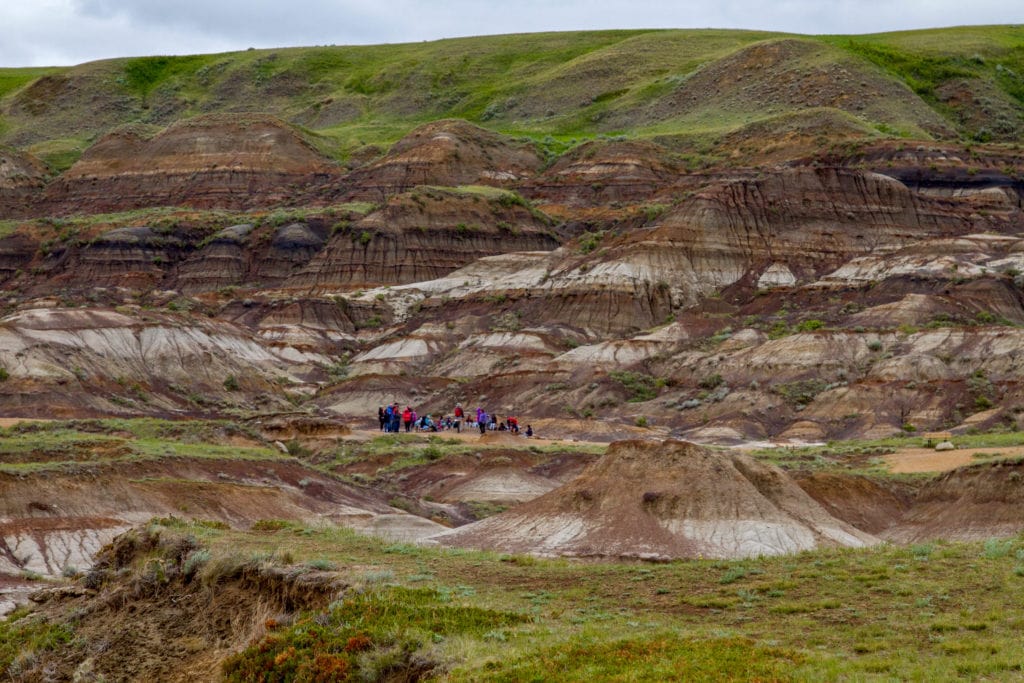After driving on Highway 9 for more than an hour, surrounded by lush green fields, the road takes an unexpected, sharp dip of about 1,200 feet. The Earth seems to drop out from beneath me and I find myself on what looks like another planet. Instead of the rich, green grassland, exposed layers of harsh gray and black sedimentary strata surrounds me on all sides.
The only color comes from a bright green dinosaur holding a bouquet of roses, and a Tim Horton’s—I’m still in Canada, after all.
Alberta Badlands
This otherworldly place is Drumheller, Alberta, the heart of the Canadian Badlands. Unlike the rosy pink U.S. badlands in North and South Dakota, this landscape—especially on a cloudy day heavy with the threat of rain—is grim.
-

“Badlands” is a geographic term that describes an arid area of loose sedimentary rock devoid of most plant life. | Photo: Bruce N. Meyer -

Alberta’s Badlands. | Photo: Bruce N. Meyer
“Badlands” is not one specific place, but a geographic term that describes an arid area of loose sedimentary rock devoid of most plant life. Because the surface rock is unstable, erosion caused by wind and rain creates an ever-changing landscape of banded gullies, hoodoos, and other unusual rock formations.
While there are badlands in several parts of Canada, this particular area stretches roughly 35,000 square miles from where Highway 10 cuts a north-to-south route from Edmonton to Calgary, and east to the Saskatchewan border.
It’s such a visually interesting environment that it’s not hard to see why downtown Drumheller and the surrounding region were chosen as the backdrop of Ghostbusters 2020, scheduled for release in July of next year. But the real draw is the dinosaurs: The remains of more dinosaur species have been found in the Alberta Badlands than anywhere else in the world.
The Dinosaur Trail
The Dinosaur Trail technically starts in Drumheller, but unless you are a paleontologist or otherwise educated in the Mesozoic Era, it’s probably best to start at the Royal Tyrell Museum of Paleontology. Here you’ll find Canada’s largest collection of fossils, representing 20 different species.
After the first major discovery occurred here in 1884, it created what paleontologists now call “The Great Canadian Dinosaur Rush.” Scientists from around the world descended upon this part of Alberta and never really left.

Among the greatest finds now on display in the museum is a 110-million-year-old dinosaur, Borealopelta markmitchelli. With skin and armor intact, it’s considered the best-preserved armored dinosaur in the world. The dinosaurs of Alberta were all herbivores, and the museum’s Cretaceous garden reflects the seasons and environmental conditions of 65 million years ago.
Several of the dinosaur remains were found in the region’s coal and mineral mines. In the 1970s, after a particularly heavy rain, a farmer found what appeared to be a log that had washed up in his field. It turned out to be a prehistoric leg bone. A road construction project near Red Deer unearthed a rare pantodont, and another family unearthed bones while digging the foundation for their new home.
The Dinosaur Capital of the World
Drumheller, home to the World’s Largest (fake) Dinosaur, more than embraces its role as the unofficial dinosaur capital of the world. The Tyrannosaurus rex, built of fiberglass and steel, stands 86 feet tall—much larger than the largest known real T. rex specimens. Visitors can climb 106 steps up into its mouth and take in the sweeping views. Pterosaurs (Greek for “wing lizards”) appear to roost on the rooftops of several downtown businesses. Colorful dinosaur footprints lead from one dino-friendly shop to the next.
When Prehistoric Park, a family-friendly theme park, closed in the 1990s, the Drumheller Chamber of Commerce took possession of the park’s more than 30 concrete dinosaurs. The playful menagerie is now the highlight of a stroll through downtown.
The Dinosaur Trail continues out of Drumheller on two routes of about 30 miles each, taking visitors past current archeological digs. If you want to get down and dirty and try to find your own dinosaur, plan on a day or two at Dinosaur Provincial Park, a UNESCO World Heritage Site near Brooks.

HooDoo Drive is about 15 miles long and beloved by photographers for the views of colorful, mushroom-shaped rocks. The Last Chance Saloon in Wayne is everything an Old West Saloon should be, with a well-worn upright piano in one corner and bullet holes in the walls from numerous card games gone bad.
But wherever the trail leads, keep your eyes open for interesting shapes. It could be the next big find in the Dinosaur Capital of the World.
If you go
Whether you prefer to get out and hike the Badlands or simply enjoy the scenery from the comfort of your vehicle, remember to bring plenty of water and sturdy shoes. The Royal Tyrell Museum of Paleontology and the Drumheller Chamber of Commerce have itineraries and activity suggestions for people of all ages and abilities.







